 |
Movie Reviews
Don’t Watch This Protestant Nativity
The Nativity Story reviewed by Marian T. Horvat, Ph.D.
Although some good critiques of the recently released movie The Nativity Story are already circulating, some of our readers insisted that TIA offer orientation on the topic. So, I went to see it. I did not harbor good expectations, but what I saw was worse than I supposed.
First, the historical facts as known by Catholic tradition were skewed and altered at every turn. Even worse, in my opinion, this most marvelous and stirring event ever to occur in History was presented in a completely naturalistic way, with no hint of the divine and noble tonus that imbued every aspect of the lives of the Holy Family. It is a Nativity wrongly conceived by Protestants, stripped of joy and the supernatural, steeped in sadness and misery.
A miserablist family vs. a Royal Family
Who could recognize the grandparents of Christ Our Lord in the poverty-stricken, penny-pinching couple presented in The Nativity Story? Vulgar and rough in manners and appearance, Joachim and Anne are shown as impecunious parents of a large family, pleased to “marry off” their daughter Mary so there will be “one less mouth to feed.” This is the explanation the niggardly Ann gives the teenager Mary when the latter sullenly protests her espousal to Joseph.
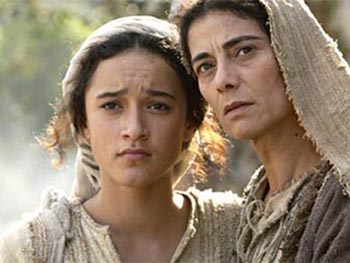
Above, the dresses of St. Anne and Our Lady are portrayed as those of proletarians in a Communist country. Below, St. Anne represented as the Princess she was
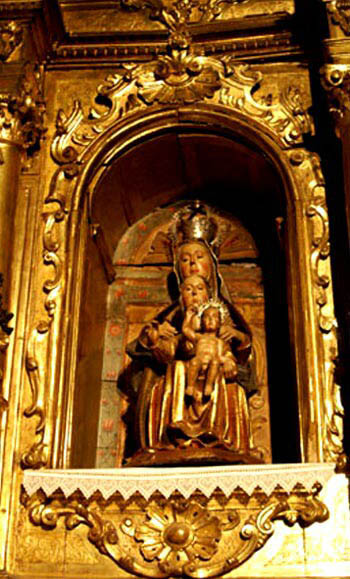 |
A little earlier, in a display of revolt, Mary bolted from the espousal ceremony to go sulk and whine that she is not “in love” with Joseph, so why should she marry him? A complete distortion of the facts we learned in Catholic catechism combined with an absurd modern, revolutionary attitude.
What we know is that St. Joachim and St. Anne were of the noble lineage of David and well-off. Childless for 20 years, the priest at the temple turned away Joachim and his offering with a reproof for his barrenness. It was then that an Angel appeared separately to both St. Joachim and St. Anne, announcing that the Lord had heard their prayer, and that Anne would bear a child whom the whole world would praise. This child of predilection was Mary, whom her parents cherished and raised with the greatest reverence, goodness and abundance, as befitted their family honor and the special destiny foretold for their daughter.
When Mary was three years, old, her parents presented her in the Temple in Jerusalem. With full knowledge of what she was doing, the child ascended the 15 great steps to the temple courtyard and entered its gates, and there she spent the next ten years of her life growing in virtue and holiness. Then she left and after a while married St. Joseph. What a beautiful episode this could have been. But there is nothing of this in The Nativity Story I viewed.
And what of St. Joseph? Quite different from what the movie presents, St. Joseph was a Prince from the dynasty of David. The Church teaches that Our Lord Jesus Christ willed to be born of noble birth, of the Royal House of David. In the first chapter of St. Matthew, we see that Joseph descends from 14 Patriarchs, 14 Kings, and 14 Princes.
While his family had lost their great wealth, by no means had they lost their nobility, the bearing and manners of princes. All patriarchal, royal and princely dignity came together in St. Joseph, the Church teaches. Tradition tells us, like Our Lady, he had the best education at the Temple. Also, like Our Lady, this most pure and decorous of men had made a vow of virginity.
He had the dignity and nobility of a prince. He was a carpenter by necessity, not by his birth and rank. However, the movie leaves aside any noble aspect to stress only the laboring carpenter, a rude young man from the lowest social level. It is another Protestant, if not a Communist approach. Like a modern lovesick youth, he is always brooding on Mary. When she leaves to visit her cousin Elizabeth after the betrothal, Joseph throws down his tools in a temper tantrum. No sanctity there.
Movie director Catherine Hardwicke claimed to be trying to present a Joseph and Mary that today’s teenagers could “relate to.” I disagree vehemently with her approach; I think today’s teenagers would admire St. Joseph as a Prince and a man of noble manners. Today’s youth are thirsty for noble manners and marvelous panoramas.
The betrothal of Joseph and Mary
In the film, the espousal scene takes place alongside the kitchen table, very banal, very pagan with no hint of a religious blessing or mention of God. The family and couple don’t even dress up for the occasion.
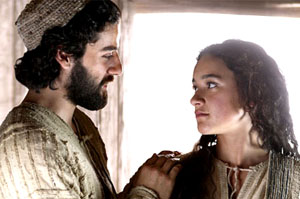
Above, the film presents the marriage betrothal as a day-to-day act. Below, Giotto pictures the solemn ceremony in the Temple
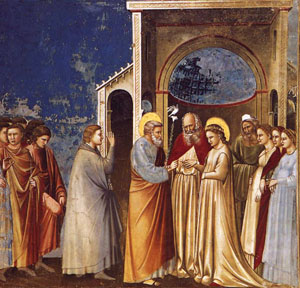
|
Joseph’s espousal to Mary Most Holy was quite different from the proletarian scene depicted in the stone hovel of Joachim. When it was decided that the Virgin Mary should marry, the high priests called together all men of marriageable age from the House of David, and in a special ceremony they ordered each man to bring a rod to the altar.
When Joseph placed his rod on the altar, it flowered and a dove descended from Heaven over him. And Mary, obedient in all things, was espoused to him, and returned to her parent’s house in Nazareth. It was there, while she was in prayer beseeching the hastening of the coming of the Messiah and the Redemption of mankind, that the Angel Gabriel appeared to her.
One of the most distorted scenes in the film is the Annunciation scene. The village girl Mary is sitting on the ground in the woods daydreaming, a peculiar grayish hawk suddenly appears in the air with eerie New Age background music to set the tone of mystery. Then suddenly, the hawk becomes an androgynous-looking angel with a curly dark hair. The whole thing is grotesque, the opposite of the sublime historical reality.
The movie clearly implies that Mary, a good girl – better than many and not as bad as most – was almost randomly chosen by God for this mission. Again, it is not true, God did not improvise the mystery of grace of the Incarnation of the Word; those who were chosen to play a role had been prepared by Him long in advance.
The depiction of Mary in this film implicitly denies that the Blessed Virgin was exempt from original sin, that she was more noble, perfect, and virtuous than any other creature ever born. From childhood she always corresponded to every grace, constantly increasing in virtue and grace, radiating peace and joy, shining in humility and charity.
A completely opposite person appears in the sullen, constantly scowling, self-engrossed teen in The Nativity Story.
The heretical presentation of the Birth of Our Lord
On the journey to Bethlehem to register for the Roman census, the film’s Joseph and Mary suffer natural hardships, without any supernatural spirit. In Jerusalem, the young couple is bedazzled by the big city; Mary swings to the music of roadside performers and proffers her hand to a fortune-teller – a clear denial of her wisdom.
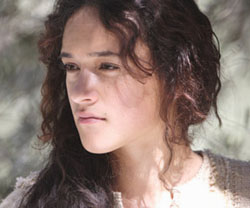
Mary portrayed as a moody, sullen teenager |
By the time they reach Bethlehem, a frantic, mad-eyed Joseph runs through the streets carrying his panting, pregnant wife asking for a room. Everything is depicted in sordid, dark Protestant colors. There is no peace, no conformity with God’s designs, and especially no supernatural atmosphere. A Communist would picture the narrative of the Gospel in the same way.
At this point, the film enters the realm of heresy and blasphemy. It is a Catholic dogma that Our Lady gave birth to the Divine Word without corruption, that is, she retained her virginity intact before the birth, during the birth, and perpetually after the birth. It is also indisputable for Catholics that she was not subject to the pains and other prosaic characteristcs of parturition, given to women as a chastisement after original sin. This Protestant film, however, portrays a painful birth of Christ, with all the details of a parturition under the law of sin. Thus, the truth of the virginal and miraculous birth of Christ is boldly denied. In its complete omission that Our Lady was not subject to the law of sin, the movie frontally attacks Catholic dogma and promotes a blasphemy.
After the child was born, according to the film, neither Mary nor Joseph adored the Word of God incarnate, Lord of Lords and King of Kings.
Plainly said, the movie is a Protestant rendition of the birth of Christ, and should be strongly rejected by Catholics. Once we could have expected the Vatican to alert the faithful not to view this heretical display. Priests would have issued warnings in their diocesan papers or from the pulpits: “Parents, don’t take your children to this movie so they won’t become confused. Instead, protest strongly against it.”
Instead, the Vatican held its first-ever hosting of a movie for The Nativity Story on November 26. An audience of seven thousand – cardinals, bishops, nuns, priests and selected Catholics – attended the showing. At the scene of the prosaic childbirth of Christ, as Joseph held a wet and bloody babe in the air, the room erupted in applause. The audience chose to completely ignore Catholic dogma. They applauded Protestantism.
In my opinion, this reaction of the Vatican is more shocking than the film itself. Instead of condemning the film for attacking Catholic doctrine, it applauds. Instead of warning the faithful that this rendition of the nativity dishonors the Mother of God, Prelates and priests recommend the film as a valiant effort by Hollywood to put Christ back in Christmas.
I guess we should not be surprised at anything from this conciliar Church: Pontiffs visit synagogues and mosques and preach in Protestant temples... Cardinals applaud Protestant movies…
For Catholics faithful to the perennial Magisterium, it is clear the stance to take on this Protestant and Communist Nativity – reject it, and do not go to this movie with your friends and family.

Posted on December 18, 2006

Related Topics of Interest
 Christmas: Victory over the Three Egoisms Christmas: Victory over the Three Egoisms
 The Santo Bambino of Ara Coeli The Santo Bambino of Ara Coeli
 Meditation on the Night of Christmas Meditation on the Night of Christmas
 With St. Joseph at Christmas: in a Sea of Peace With St. Joseph at Christmas: in a Sea of Peace
 The Role of St. Joseph The Role of St. Joseph
 The Moral Profile of St. Anne The Moral Profile of St. Anne
 The Presentation of Mary in the Temple The Presentation of Mary in the Temple

|
Movies | Home | Books | CDs | Search | Contact Us

© 2002- Tradition in Action, Inc. All Rights Reserved
|
 |
|